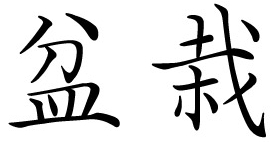The word “Bon-sai” (often misspelled as bonzai or banzai) is a Japanese term which, literally translated, means “planted in a container”. This art form is derived from an ancient Chinese horticultural practice, part of which was then redeveloped under the influence of Japanese Zen Buddhism.
It has been around for well over a thousand years. The ultimate goal of growing a Bonsai is to create a miniaturized but realistic representation of nature in the form of a tree. Bonsai are not genetically dwarfed plants, in fact, any tree species can be used to grow one.
Bonsai definition
The Chinese characters for their older dwarf potted tree landscapes were adopted to name the Japanese art-form. In short, the definition of Bonsai can be explained as:

“Bon” [left character] is a dish or thin bowl (“a modified vessel which has been divided or cut down from a deeper form”).
“Sai” [right character] is a tree or other growing plant which is planted – “planted,” as would be a halberd or spear or pike stuck into the ground.
“Bonsai” thus means or denotes “a tree which is planted in a shallow container”.
What is a Bonsai tree exactly?
Techniques such as pinching buds, pruning and wiring branches, and carefully restricting but not abandoning fertilizers are used to limit and redirect healthy growth. Most commonly kept under four feet (or about a meter) in height, Bonsai are not genetically dwarfed plants. However, plants with smaller leaves do make these compositions easier to design. In fact, any plant species that has a woody stem or trunk, grows true branches, can be successfully grown in a container to restrict its roots/food storage capability, and has smaller or reducible-leaves can be used to create a Bonsai.
Bonsai size classifications
The ultimate goal of Bonsai is to create a realistic depiction of nature. As a Bonsai gets smaller (even down to a few inches/centimeters) it increasingly becomes abstract, as opposed to resembling nature in a more precise way. Several classifications of Bonsai have been put forward, and although the exact size classifications are disputed, they help to gain understanding of the aesthetic and botanical aspects of Bonsai. The classifications are originally based on the number of men needed to lift the actual tree.
The size classifications, increasing in size
- Keshitsubo: 1-3″ (3-8 cm)
- Shito: 2-4″ (5-10 cm)
- Mame: 2-6″ (5-15 cm)
- Shohin: 5-8″ (13-20 cm)
- Komono: 6-10″ (15-25 cm)
- Katade-mochi: 10-18″ (25-46 cm)
- Chumono / Chiu: 16-36″ (41-91 cm)
- Omono / Dai: 30-48″ (76-122 cm)
- Hachi-uye: 40-60″ (102-152 cm)
- Imperial: 60-80″ (152-203 cm)
Thanks to www.bonsaiempire.com for this information.